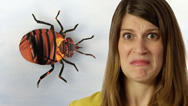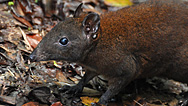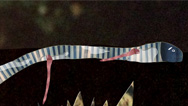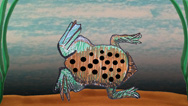Five Gross Facts About Koalas
- Posted 11.26.15
- NOVA
Think koalas are cute? Think again. Find out just how strange these animals are in this episode of Gross Science.
Transcript
Five Gross Facts About Koalas
Posted: November 26, 2015
Think koalas are cute? Think again. Here are five gross facts about koalas.
I’m Anna Rothschild, and this is Gross Science.
Number 1. Baby koalas, called joeys, eat their mothers’ poop. For the first six months or so after they’re born, they drink milk from a teat in their mom’s pouch. But then, for several weeks, they eat…fecal matter. The joey sticks its head out its mom’s pouch and nuzzles her butt. She releases some normal poop pellets, followed by a runnier, protein-rich substance, called pap. The pap helps the baby grow, and is full of the mom’s gut bacteria, which could help prepare the joey for its adult diet of eucalyptus leaves.
Number 2. Like many other marsupials, the penises of male koalas have two prongs. But, that’s nothing compared to the female, which has two vaginas and what’s called a vaginal cul-de-sac. Sperm travels up the vaginas on either side, and babies leave through the cul-de-sac, actually breaking through the bottom. After birth, the cul-de-sac heals.
Number 3. Males use a loud belching noise called a bellow for attracting mates and for other communication. A unique vocal organ at the back of their throats makes their calls extremely low. In fact, the koala’s bellow is about 20 times lower than it should be for an animal of its size.
Number 4. A mature male koala has a scent gland on his chest, which oozes dark, smelly gunk that he rubs on trees. No one’s entirely sure what the gunk’s for, but it could be to signal that he’s ready to mate, or to mark his territory. Koalas aren’t known to be super territorial, but that’s not always the case…
Number 5. Wild koalas in Australia face some major threats, like habitat destruction, brushfires, an HIV-like virus that suppresses their immune system, and even chlamydia. The strains that infect koalas are different from the sexually transmitted disease we get. But koala chlamydia also spreads through mating, and mothers can transmit it to their joeys. It can make the animals blind, incontinent, infertile, and even kill them. And it’s pretty prevalent—in some places up to 90% of the koala population has been infected.
Now, it’s not clear exactly how critical koalas are to maintaining stability in the ecosystem. But personally, I don’t want to risk it. We simply don’t know what losing these guys to disease or habitat disruption could mean for eucalyptus forests. And besides, koalas are deeply important cultural icons—think about it, they’re basically synonymous with “Australia”…along with kangaroos and vegemite. So, no matter how strange these animals are, I for one wanna save them.
I guess you’re still kinda cute. Ew.
Credits
PRODUCTION CREDITS
- Host, Producer, Editor, Animator, Additional Research
- Anna Rothschild
- Researcher, Writer
- Elizabeth Preston
- DP, Sound, Additional Research
- Ceri Riley
- Perfectly B
- Music Provided by APM
IMAGES AND VIDEO
- Original Footage
- ©WGBH Educational Foundation 2015
- Audio and video of Koala Velar Vocal Fold Vibrations
- Courtesy Dr. Benjamin Charlton
- A video recording of a bellowing male koala (Phascolarctos cinereus) (called Andy) at Lone Pine Koala Sanctuary.
- Movie S1 from: Charlton, B. D., Ellis, W. A. H., McKinnon, A. J., Brumm, J., Nilsson, K., & Fitch, W. T. (2011). Perception of Male Caller Identity in Koalas (Phascolarctos cinereus): Acoustic Analysis and Playback Experiments. PLoS ONE, 6(5), e20329. http://doi.org/10.1371/journal.pone.0020329
- Koala (Phascolarctos cinereus) newborn in pouch, Australia
- Getty Images/Roland Seitre
- young joey in pouch eating pap
- Shutterstock/WF
- Portrait of male Koala bear, Phascolarctos cinereus, 3 years old, in front of white background, studio shot
- Pond5/lifeonwhite_photos
- Koala chases girl riding an ATV and attacks
-
Ebony Churchill/ViralHog.com
http://bit.ly/1HPYrO5 - Brushfire
- Pond5/EcoMedia
- Cutest Koala
- Wikimedia Commons/Erik Veland
- Phascolarctos cinereus -ZooParc de Beauval, France -upper body- 8a
- Wikimedia Commons/frank wouters
- Baby Koala
- Wikimedia Commons/حسان هواري
- Koala with young
- Wikimedia Commons/Brian Dell Bdell555
- Koala Eating
- Wikimedia Commons/(--Pumpmeup)
- Friendly Male Koala
- Wikimedia Commons/Quartl
- Koala
- Wikimedia Commons/Summi
- A cranky-looking koala, sitting beside the road on the way to Apollo Bay
-
Flickr/Shiny Things
(used with permission from author) - Koala02
- Wikimedia Commons/Mike R
- The World Factbook - Australia - Flickr - The Central Intelligence Agency (19)
- Wikimedia Commons/The Central Intelligence Agency
- Koala being treated for chlamydia
- Ari Daniel/WGBH Educational Foundation
- Koala and joey
- Wikimedia Commons/Benjamint444
- Koala Eating (3337014192)
- Wikimedia Commons/Rennett Stowe from USA
- Australia satellite plane
- Wikimedia Commons/Reto Stöckl / NASA Goddard Space Flight Center
- Macropus rufus in ZOO Plock
- Wikimedia Commons/Bardrock
- Vegemiteontoast large
- Wikimedia Commons/Tristanb
SFX
- Cockroaches
-
Freesound/StateAardvark
(used with permission from author) - Squeak Pack/squeak_10
- Freesound/Corsica_S
- Swishes
- Freesound/Pogotron
- Produced by WGBH for PBS Digital Studios
POSTER IMAGE
- Cutest Koala
- Wikimedia Commons/Erik Veland
Sources
Want more info?
Additional info about the koala life cycle:
http://bit.ly/1HPTmW4
Info on the koala reproductive system:
http://bit.ly/1HPPVi8
Primary literature on the koala’s unique vocal organ
(article behind paywall):
http://bit.ly/1HPTQLW
Nature article on the koala’s bellow:
http://bit.ly/1HPTZ1P
NOVA/PRI’s The World report on koala chlamydia:
http://to.pbs.org/1HPUdWP
Related Links
-

Gross Science
Bizarre stories from the slimy, smelly, creepy world of science.
-

Australia: Strange Creatures
After a massive extinction, diverse marsupials came to dominate this isolated continent.
-

Flesh-Eating Amphibian Babies
Caecilian mothers have a very strange way of feeding their young.
-

How Surinam Toads Give Birth
Surinam toad babies burst from the skin of their mother's back.

